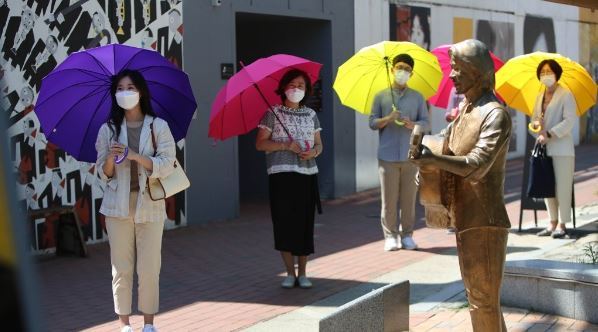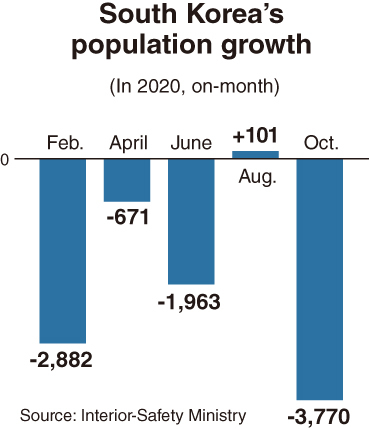[News Focus] Korea’s population decline accelerates in October
Highest negative growth seen recently since Dec. 2019
By Kim Yon-sePublished : Nov. 5, 2020 - 17:13

SEJONG -- South Korea posted the biggest population decline in October since the nation’s population began to fall again in December 2019.
This also marked the second-largest decline since the nation began compiling the relevant data, after the figure of minus 5,303 reported in March 2008. But that drop was an outlier in the middle of steady positive growth.
According to the Ministry of Interior and Safety, the population was 51.838 million as of last month, falling by 3,770 (3,284 for men and 486 for women) from 51.841 million in September.
Korea saw the population decline for seven consecutive months, from December 2019 to June 2020. Though the monthly figure inched up for the third consecutive month, between July and September, it plunged again in October.

Compared to November 2019, when the demographic figure peaked at 51.851 million, it dropped by 13,411 collectively over the past 11 months.
Before December 2019, the nation saw its population decline only twice -- in March 2008 (by 5,303) and April 2009 (by 2,716). And for a decade from May 2009 to November 2019, the population continually increased on-month.
Last month, among the 17 major cities and provinces, Seoul saw the biggest population decrease, as the capital posted minus 10,073 in the number of residents, followed by Daegu with minus 2,678, Busan with minus 2,151, Daejeon with minus 1,543, Gwangju with minus 958 and South Gyeongsang Province with minus 939.
Only five of the 17 areas reported a population increase: They were Sejong, Gyeonggi Province, Gangwon Province, North Chungcheong Province and Jeju Province.
Korea renewed the record-low in the number of births -- 21,138 in October. The figure contrasts with 39,349, posted five years earlier in October 2015 and 42,329, a decade earlier in October 2010.
The number of births was outstripped by deaths: 21,138 vs. 25,959. While the gap between the two was 4,821, citizenship changes (Koreans renouncing their citizenship and foreigners acquiring Korean citizenship) and the long-term resident status of Koreans overseas and foreign nationals here are estimated to have offset the population decline somewhat, reducing it to 3,770.
Alongside the low fertility rates, the portion of elderly population is climbing rapidly.
The tally for those aged 70 or over came to 5.67 million, which made up 10.9 percent of the entire population, 51.83 million. While those aged 60 or over posted 12.34 million, and 20.99 million people in Korea were 50 or older last month.
As for those aged 65 or over (the United Nations threshold for being considered senior), the age group grew to 8.43 million, or 16.3 percent of the population.
All these figures above marked new all-time highs.
The situation contrasts with the youth aged under 15. The percentage of people aged between zero and 14 stood at the record low of 12.2 percent, or 6.36 million.
Meanwhile, the nation’s female residents outnumbered its male residents by about 142,000 as of last month -- a disparity of 25.99 million vs. 25.84 million across the nation.
The sex ratio, or the number of men per 100 women, posted an all-time low of 99.4, compared with 10 years earlier in October 2010, when it reached 100.4.
By Kim Yon-se (kys@heraldcorp.com)



![[Herald Interview] 'Amid aging population, Korea to invite more young professionals from overseas'](http://res.heraldm.com/phpwas/restmb_idxmake.php?idx=644&simg=/content/image/2024/04/24/20240424050844_0.jpg&u=20240424200058)












![[KH Explains] Korean shipbuilding stocks rally: Real growth or bubble?](http://res.heraldm.com/phpwas/restmb_idxmake.php?idx=652&simg=/content/image/2024/04/25/20240425050656_0.jpg&u=)

